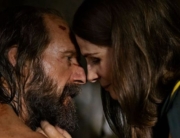When you’re looking at a Hieronymus Bosch painting, the devil lies writhing and snarling in the details: a pair of buttocks bleeds astride a giant knife. A mob of naked drunks guzzle out of a leaky barrel and empty their bowels at the same time. A fish in kinky boots devours a man whose bulbous belly and skinny legs hang out of its gaping maw. With unequaled access to Bosch’s work, Hieronymus Bosch: Touched by the Devil vividly showcases the hellfire horrors of the art through powerful lenses that magnify every brushstroke. What this terminally tasteful and conflict-averse film does not do is tell a compelling story around it.
The movie documents the efforts of a group of Dutch art curators to put together an exhibit of Bosch’s oeuvre in the museum of his hometown in the Netherlands, Den Bosch, to commemorate the 500th anniversary of his death. Group leader Matthijs Ilsink wants to authenticate, date, and restore major pieces scattered all over the world. So the gang has to go hat in hand to some big-time museums, asking for access.
The group is very proud of its scientific and standardized methods. Those attributes do not impress everyone they meet, though, particularly the leadership at Madrid’s regal Prado Museum. You can feel saturnine director Gabriele Finaldi barely restraining himself from giving the Dutch a cold bum’s rush. One of his henchwomen gleefully gloats, “The decision [to lend artwork] is ours. Because they have no Bosches and we do.” We wait for the drama inherent in this conflict of wills to be explored, but it fizzles into just another episode of art world politics on display as the group makes its rounds.
Where the film comes alive is in its mind-blowing views of Bosch masterpieces such as The Haywain. Close-ups reveal the Boschian grotesqueries we love to revel in, but also tenderness we don’t expect (a tear on the face of an exhausted Jesus, the baleful gaze of vigilant owls). Wider shots give a sense of some of the works’ vastness and epic sweep. Underdrawings exposed by computer imagery reveal where Bosch expanded on or completely abandoned original plans. And creative analytical methods try to unlock the authenticity of the paintings: historians blowup every rendition of human ears in Bosch’s work and lay them side by side, seeking to see whether the styles match up.
All this art is amazing. But the film’s central figures can’t always help us understand it or feel its power. They clearly live in a rarefied art historian bubble, which can make their pronouncements about the art confusing to those of us who do not. Prado director Finaldi spends a lot of time declaring that Bosch’s works point out how the Netherlands and its visual style were very important for Spain and for its king, Philip II. Well, how exactly? It’s noteworthy that two American art historians, John Hand and Catherine Metzger at Washington, D.C.’s National Gallery, talk about the art in accessible terms and with an affection that contrasts with the Europeans’ more measured, even effete approach.
The American curators seem willing to advance a thesis about the art’s context and meaning, and they express a stronger view of the work than Ilsink, who makes vague statements about God, man, and creativity. Like the historian, Hieronymus Bosch holds back from really connecting with the wild imagination at its center. A neutral palette and beige soundtrack highlight the overall sense of restraint.
In the last few moments of the film, we hear from the director of the Nelson-Atkins Museum of Art in Kansas City, MO, Julián Zugazagoitia. His museum holds The Temptation of Saint Anthony, which Ilsink and team have identified on camera as a genuine Bosch. Zugazagoitia is over the moon. It’s a moment of excitement and keen pleasure that Bosch’s work should have led us to all along the way. Somewhere, an owl is scowling reproachfully.

















Leave A Comment